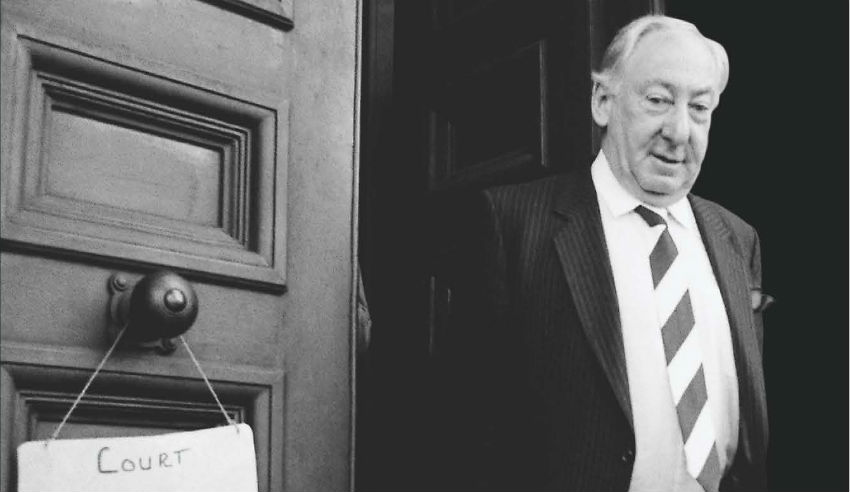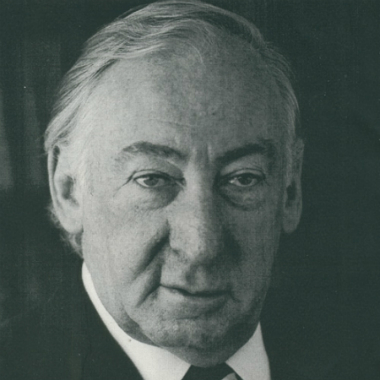More than three decades after being sealed by Parliament, secret allegations levelled against the late Lionel Murphy QC have been described as a tawdry and repetitive exercise to cast doubt on the legacy of the former High Court judge.

New documents released by federal Parliament have returned the spotlight on one of the most controversial political and judicial scandals in Australian history. But the veracity of the archives and what they can add to our understanding of the truth remains contentious.
In 1986, the Hawke government legislated to repeal the commission inquiring into various allegations of improper conduct and sealed the associated documents outlining the allegations against the judge for 30 years. That time period expired in 2016 and last week thousands of pages of declassified files were made public.
Lionel Murphy is the only High Court judge to have been subjected to a parliamentary investigation that may have resulted in his removal from the bench under Section 72 of the Constitution for “proved misbehaviour or incapacity”.
Historians, academics, journalists and legal pundits have been poring over the declassified files to get a better sense of how these new details add to what is already known about the sensational controversy the High Court judge was embroiled in the three years leading up to his death. He passed away aged 64.
Professor Jenny Hocking, the author of Lionel Murphy – A Political Biography, told Lawyers Weekly that it was incorrect to describe the latest tranche of documents as some final chapter to the affair. She admonished recent media commentary which implied the details of the allegations put to the commission of inquiry offered any kind of “final chapter” to Lionel Murphy’s legacy.
“The documents are, in fact, just the beginning of another episode of what is now another tawdry, repetitive search for error on Murphy’s part. There is no truth in those documents on their own,” Professor Hocking said.
“It is impossible to draw the truth, certainly from these documents because they are only the beginning of a commission of inquiry,” she said.
Writing for The Conversation, legal academic Professor Andrew Lynch said that the release of the documents would “reopen old debates and inevitably lead to fresh appraisals of Lionel Murphy’s life and career”. His assessment of documents conclude that it would have been untenable for the judge to remain on the bench but underscores that the commission did not have an opportunity to complete its inquiry.
“The records bring vividly to life the controversy that by mid-1986 swirled ceaselessly around Murphy. There are 41 separate files of allegations against the judge, as well as a general file of ‘accusations and letters of support’,” Professor Lynch said.
The legal academic from the University of New South Wales explained that a number of the allegations in these achieved files canvassed similar ground to the issues that were probed in two separate Senate committee inquiries two years prior in 1984, and the subsequent criminal trials of which the judge was ultimately acquitted of any wrongdoing.
Professor Lynch added however that some of the Class A allegations did raise new claims of illegal or improper conduct. These included an allegation of attempted bribery of Commonwealth officers or urging them to breach duties of non-disclosure. He also noted an allegation that the judge had tried to get a senior AFP policeman to act as an inside informant to the Australian Labor Party (ALP).
Not only have the new public documents raised further questions about Lionel Murphy’s “complex” legacy, but the information has also gone some way to illustrating the scandalous nature of politics in 1980s Australia, Professor Lynch suggested.
Of those allegations which were set aside by the commissioners (comprising three retired judges who were appointed to the role) Professor Lynch listed a range of what he called “outlandish” claims, “reheated from years earlier and already known to be baseless”.
“These included allegations of tax avoidance, improper use of travel entitlements that Murphy accessed through his wife’s work as a travel consultant with Ethiopian Airlines, the provenance of a diamond owned by Mrs Murphy, and, an all-too predictable conspiracy theory given the times – that the judge was a Soviet spy and a member of an espionage ring operating in Canberra,” Professor Lynch said.
The question remains, to what extent can any of the 14 allegations against Lionel Murphy revealed in the past week better inform the historical record.
According to Professor Hocking, the fact that the commission’s work was never finalised is an important issue that must be considered. She noted that another thing to bear in mind was that the parliamentary commission terms of reference were remarkably broad and allowed for allegations against Lionel Murphy to be made in an open slather fashion.
“They were literally inviting people to come forward with any material from any time of Lionel Murphy’s life about any aspect of his life. There was a lot of criticism at the time that the terms of reference were not confined, that they were very broad and literally invitations to allege,” Professor Hocking said.
“You have to remember also that Murphy had already been through three such inquiries, two of them being the senate inquiries (in 1984), which both found the original material being inquired into, couldn’t be substantiated as verifiable material.”
The original material Professor Hocking describes is a series of telephone conversations, secretly recorded and transcribed by NSW Police and then leaked to journalists at The Age. The newspaper then used these transcripts to report that a judge and solicitor had discussed a range of potentially criminal matters, as well as raise the suggestion that the pair had ties to criminal groups.
One tape in The Age tapes supposedly identified Murphy under parliamentary privilege as the judge involved in the reported scandal. He was also accused of attempting to influence other judges who were presiding over a matter that involved forgery and conspiracy charges against solicitor Morgan Ryan, who later famously became referred to as Murphy’s “little mate”.
“There’s a real question mark over that very early material,” Professor Hocking said.
The Monash University academic said that she believed when a determination had been made to discredit The Age tapes, that is where the saga should have ended. But indeed, it continued and resulted in what she described was an unprecedented “reputational inquiry after inquiry”. She added that the shocking, targeted use of Parliament and courts to pursue the High Court judge cannot be removed from the political circumstances of the time.
“There were determined efforts to remove Lionel Murphy from the bench and you cannot separate out the politics from the legal aspects of this in any way, shape or form.
“I think he was treated absolutely appallingly. From the moment he went on the bench, it was very clear from the conservative side of politics that there would be moves made – and this was said publicly – to ensure that he would not remain long on the bench,” Professor Hocking said.
Justice Murphy took leave from the High Court when the second Senate commission of inquiry in 1984 found he had a case to answer. The Commonwealth DPP then laid charges against the judge before Parliament moved to make a decision about what it would do to address the judge’s position.
He was acquitted in July 1985 on one charge of attempting to pervert the course of justice but found guilty of another. Murphy successfully appealed the 18-month jail sentence imposed on him and was acquitted at the retrial for the second charge.
“The only truth of a person’s life can be gauged from an examination of their entire life and that’s the only way in which really to assess both the legacy of Murphy as a jurist and as a very successful reforming attorney-general,” Professor Hocking said.
“We also need to understand the context in which these documents have come from and why there was such determined efforts to remove him. Given that he’d been acquitted on the other grounds to come out at trial, the final commission of inquiry [in 1986] was extremely controversial.
“The bottom line is that he was acquitted of the charges he faced at trial and it’s an absolute tragedy and scandal that the matter was not allowed to rest there.”

Lionel Keith Murphy QC - Image courtesy of High Court of Australia